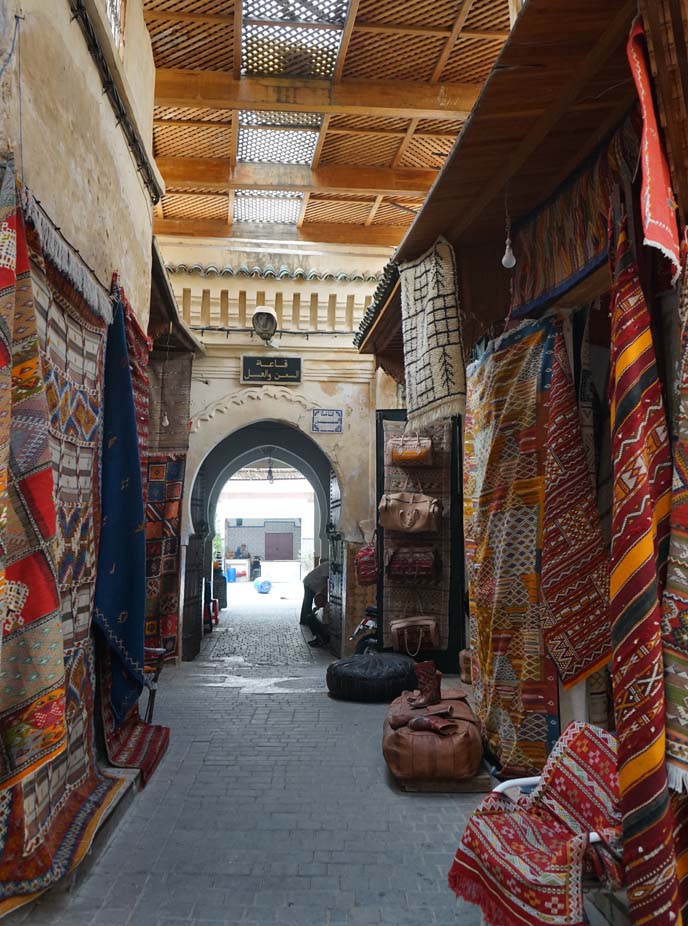Adventures in Morocco

Are you planning a trip to Morocco? Our favorite travel writer and professional nomad La Carmina just returned from the hottest new destination and has some great inspiration for us:
"Those majestic doors can be found nowhere else… We made it to Morocco!
I have to admit: I felt a bit of trepidation before arriving in Fez. I’d heard quite a few stories from travelers who felt uncomfortable in the markets, especially if they were women traveling solo.
It turned out that my experience was the exact opposite. I felt relaxed walking through the souks: nobody bothered my filmmakers and me, or called out comments harsher than “Nice hair!”
I now realize how lucky we were to have Plan-It-Fez-Tours with us. Thanks to our Arabic-speaking guide, we were able to meet artisans and discover the rich culture of the medina — without ever feeling lost, or at the mercy of touts.

In this photo diary, I’ll expand more on what we did and saw in the Fes medina.
Fez (or Fes) was the medieval capital of Morocco, and feels preserved in time. Spice markets, twisting narrow alleys surrounded by high walls, hidden prayer halls, and ornamental doorways add to the mysterious atmosphere.

It’s easy to get lost in the sprawling pathways, so use the Blue Gate (Bab Boujloud) as a landmark. The blue color on one side symbolizes Fez, and the green represents Islam. This area is surrounded by street food stalls and restaurants.


A note on dress code: Morocco is a Muslim country, and the local women generally wear headscarves and cover their arms and legs. Out of respect, I’d suggest wearing something that at least covers your limbs (I brought a light scarf for my shoulders). At the same time, don’t stress too much about wardrobe, since tourists in revealing outfits are a common sight here.
The weather is almost always hot, so I recommend wearing a long maxi dress made of lightweight cotton fabric.

We got to meet Moroccan artists, bakers, beauty experts and more — and communicate with them, through our bilingual guide.
Our guide took us to try a unique activity: a drum-making-workshop. We learned how to make traditional Moroccan drums from start to finish, beginning with painting the ceramic jugs in the Berber style…

… then scraping the hides and adding the leather “skin” on top, which is bound in place with needle and thread.What an incredible feeling, to be crafting a musical instrument in the traditional method, right in this UNESCO heritage site.


We learned how to draw blue decorative lines around the jar, using a manual pottery wheel and brush. Then, I used a brush to draw X shapes, circles, and other Berber designs. Don’t laugh! It’s harder than it looks to create an even thickness.

A child peeked around the corner and watched me work.

My drum is a little shaky, but finished! Our guide suggested that we paint half of it in the traditional way, and half in our own style — so I added a certain Scottish Fold cat.Filmmaker Melissa completed the other drum, and the two were bound together with camel skin and leather ties. You also have the option of putting goat or fish skin over the drum, which creates different sounds. And of course, you get to take the instrument home with you.

Filmmaker Melissa completed the other drum, and the two were bound together with camel skin and leather ties. You also have the option of putting goat or fish skin over the drum, which creates different sounds. And of course, you get to take the instrument home with you.

We ended this happy day by playing drums with the musicians.

Time to take a break from the hot weather, and relax back at our glorious Palais Faraj hotel.
I adore Moroccan art and architecture, and staying here felt like being in an enchanted Arabian palace. The front entrance alone is a work of art, with royal horseshoe arches and thousands of colored tiles.

My Egyptian Eye and Pyramid dress adds to the magic and mystery.

Palais Faraj is designed by Jean-Baptiste Barian, a famous architect and interior designer known for his Andalusian Arabic style.


Every evening, we looked forward to dinner at L'Amandir restaurant. As the sun set over the hilltops, we watched the old city light up while we dined on Fassi cuisine (the local flavors of Fez).

My new favorite appetizer: Moroccan salads. The waiter brought out this rainbow spread of vegetarian dishes, including eggplant and carrots in the highest quality honey. We loved this assortment so much that we immediately ordered it the next day.
L’Amandier is one of the top-rated restaurants in the city, and for good reason. The menu included Moroccan favorites such as couscous, tagines and pigeon pastillas, paired with local wines. Even if you aren’t staying at the hotel, it’s well worth coming here for dinner with a view.

Perhaps the St Augustine quote puts it best. “The world is a book, and those who do not travel read only a page.”





